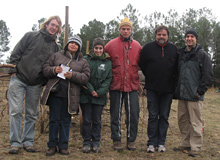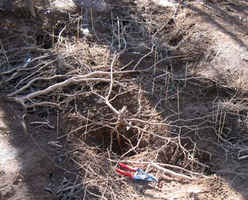Study of Architecture in Bordeaux Sheds Light on Roots

Post-doctoral Associate Josh Caplan recently spent three weeks analyzing architecture in Bordeaux, France. He was not studying the famed 18th century architecture, however; he was learning techniques for analyzing the architecture of root systems. Josh is part of a research team, led by Joan Ehrenfeld and Jason Grabosky, investigating the role of roots in plant invasions.
 Their project emerged out of the observation that invasive plants are frequently able to rapidly capture and use environmental resources such as soil nitrogen, water, and carbon dioxide. The team hypothesizes that the structure of root systems may contribute strongly to the advantages invasive plants show in competing for belowground resources. In order to test this hypothesis, the research team has adapted methods to unearth root systems, generate computerized representations of the root systems, and analyze the representations with specialized computing techniques. Josh went to France to learn the computing techniques from one of the scientists who pioneered them, Frederic Danjon.
Their project emerged out of the observation that invasive plants are frequently able to rapidly capture and use environmental resources such as soil nitrogen, water, and carbon dioxide. The team hypothesizes that the structure of root systems may contribute strongly to the advantages invasive plants show in competing for belowground resources. In order to test this hypothesis, the research team has adapted methods to unearth root systems, generate computerized representations of the root systems, and analyze the representations with specialized computing techniques. Josh went to France to learn the computing techniques from one of the scientists who pioneered them, Frederic Danjon.
 Now that Josh is equipped to do so, he will compare rooting characteristics between a set of the Northeast's most problematic invasive shrubs (Japanese barberry, bush honeysuckle, and wineberry) and a set of shrub species native to the region (spicebush, arrowood viburnum, and Allegheny blackberry). The team is especially interested in architectural characteristics that describe how efficient roots are at exploring for nutrient patches in the soil and how completely they exploit the patches that they find. "Believe it or not, people have come up with ways to measure how thoroughly something that is branched fills space. Some of these come from the fact that roots systems are nearly fractals, while others quantify how the branches are connected; the topology," explains Josh.
Now that Josh is equipped to do so, he will compare rooting characteristics between a set of the Northeast's most problematic invasive shrubs (Japanese barberry, bush honeysuckle, and wineberry) and a set of shrub species native to the region (spicebush, arrowood viburnum, and Allegheny blackberry). The team is especially interested in architectural characteristics that describe how efficient roots are at exploring for nutrient patches in the soil and how completely they exploit the patches that they find. "Believe it or not, people have come up with ways to measure how thoroughly something that is branched fills space. Some of these come from the fact that roots systems are nearly fractals, while others quantify how the branches are connected; the topology," explains Josh.
 In addition to improving ecologists' understanding of plant invasion dynamics, the research may yield some very practical benefits. Because many herbicides that are used to control invasive plants target roots, a better ability to predict root biomass could help natural resource managers apply herbicides more efficiently and effectively. The current research program will test the viability of this idea for the three invasive species listed above. Further off, if characteristics of root architecture prove to be useful in separating invasive from non-invasive plants, root system characteristics may be useful in screening plants being considered for introduction, thereby preventing the import of likely invaders.
In addition to improving ecologists' understanding of plant invasion dynamics, the research may yield some very practical benefits. Because many herbicides that are used to control invasive plants target roots, a better ability to predict root biomass could help natural resource managers apply herbicides more efficiently and effectively. The current research program will test the viability of this idea for the three invasive species listed above. Further off, if characteristics of root architecture prove to be useful in separating invasive from non-invasive plants, root system characteristics may be useful in screening plants being considered for introduction, thereby preventing the import of likely invaders.


